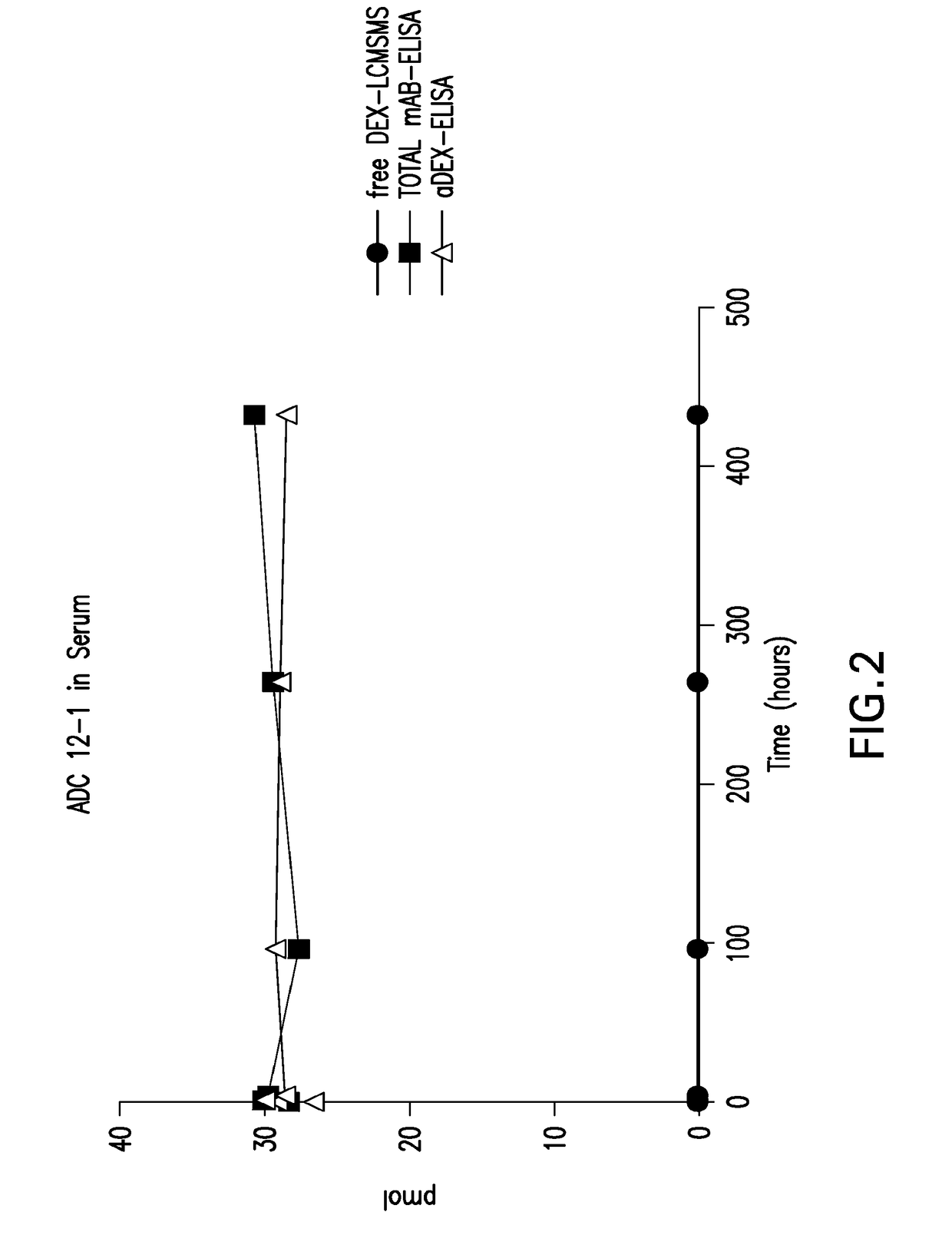Phosphate based linkers for intracellular delivery of drug conjugates
a phosphate-based linker and drug conjugate technology, applied in the direction of immunoglobulins, immunoglobulins against animals/humans, peptides, etc., can solve the problems of drug use, drug toxicity, inappropriate drug release, etc., and achieve the effect of antibody-drug conjugate in the drug field
- Summary
- Abstract
- Description
- Claims
- Application Information
AI Technical Summary
Benefits of technology
Problems solved by technology
Method used
Image
Examples
example 1
[0238]The synthesis of dexamethasone linker 2-(2-(cyclooct-2-yn-1-yloxy)acetamido)ethyl (2-((8S,9R,10S,11S,13S,14S,16R,17R)-9-fluoro-11,17-dihydroxy-10,13,16-trimethyl-3-oxo-6,7,8,9,10,11,12,13,14,15,16, 17-dodecahydro-3H-cyclopenta[a]phenanthren-17-yl)-2-oxoethyl) dihydrogen pyrophosphate (1-4) was as follows.
Step A: 2-((8S,9R,10S,11S,13S,14S,16R,17R)-9-fluoro-11,17-dihydroxy-10,13,16-trimethyl-3-oxo-6,7,8,9,10,11,12,13,14,15,16,17-dodecahydro-3H-cyclopenta[a]phenanthren-17-yl)-2-oxoethyl dihydrogen phosphate (1-1)
[0239]To a stirred solution of dexamethasone (0.40 g, 1.02 mmol) in THF (2.0 mL) at −40 C was added diphosphoryl chloride (0.31 mL, 2.24 mmol) and the resulting mixture was stirred at −40° C. for 1 hr. The reaction was quenched with water, and treated with saturated sodium bicarbonate solution until pH˜8. The solution was made acidic using 1N HCl solution and extracted several times with ethyl acetate. The combined organic phase washed with brine, dried over sodium sulfat...
example 2
[0243]The synthesis of dexamethasone linker 2-(2-(cyclooct-2-yn-1-yloxy)acetamido)ethyl (2-((8S,9R,10S,11S,13S,14S,16R,17R)-9-fluoro-11,17-dihydroxy-10,13,16-trimethyl-3-oxo-6,7,8,9,10,11,12,13,14,15,16,17-dodecahydro-3H-cyclopenta[a]phenanthren-17-yl)-2-oxoethyl) trihydrogen triphosphate (2-7) was as follows.
Step A: 1, 3-dioxoisoindolin-2-yl 2-(cyclooct-2-yn-1-yloxy)acetate (2-1)
[0244]To a stirred solution of 2-(cyclooct-2-yn-1-yloxy)acetic acid (0.20 g, 1.10 mmol) in DCM (4.0 mL) was added N-hydroxyphthalimide (0.36 g, 2.20 mmol) and EDC (0.42 g, 2.20 mmol). The resulting mixture was stirred at room temperature for 45 minutes. The reaction was directly injected onto a silica gel column and flash column separation using a 0-50% ethyl acetate / hexane gradient gave 2-1 as a solid (335 mg, 93%)
Step B: (9H-fluoren-9-yl)methyl dihydrogen phosphate (2-2)
[0245]The title compound was prepared from (9H-fluoren-9-yl)methanol according to the protocol outlined in Example 1-1 to afford 2-2. LRM...
example 3
[0251]The synthesis of dexamethasone linker 4-(2-(cyclooct-2-yn-1-yloxy)acetamido)phenyl (2-((8S,9R,10S,11S,13S,14S,16R,17R)-9-fluoro-11,17-dihydroxy-10,13,16-trimethyl-3-oxo-6,7,8,9,10,11,12,13,14,15,16,17-dodecahydro-3H-cyclopenta[a]phenanthren-17-yl)-2-oxoethyl) dihydrogen pyrophosphate (3-4) was as follows.
Step A: (9H-fluoren-9-yl)methyl (4-hydroxyphenyl)carbamate (3-1)
[0252]To a stirred solution of 4-aminophenol (0.30 g, 2.75 mmol) in DCM (9 mL) was added (9H-fluoren-9-yl)methyl carbonochloridate (0.71 g, 2.75 mmol) and the resulting mixture was stirred at room temperature for 2 hours. The mixture was partitioned between ethyl acetate and 1 N HCl solution. To the organic phase was added methanol until the solution cleared. The organic phase was dried over sodium sulfate and concentrated onto silica gel and flash column separation using a 100% ethyl acetate gave 3-1 as a solid (634 mg, 70%). LRMS (ES) (M+H)+: observed=332.3, calculated=331.3
Step B: (9H-fluoren-9-yl)methyl (4-(ph...
PUM
| Property | Measurement | Unit |
|---|---|---|
| length | aaaaa | aaaaa |
| particle size | aaaaa | aaaaa |
| particle size | aaaaa | aaaaa |
Abstract
Description
Claims
Application Information
 Login to View More
Login to View More - R&D
- Intellectual Property
- Life Sciences
- Materials
- Tech Scout
- Unparalleled Data Quality
- Higher Quality Content
- 60% Fewer Hallucinations
Browse by: Latest US Patents, China's latest patents, Technical Efficacy Thesaurus, Application Domain, Technology Topic, Popular Technical Reports.
© 2025 PatSnap. All rights reserved.Legal|Privacy policy|Modern Slavery Act Transparency Statement|Sitemap|About US| Contact US: help@patsnap.com



